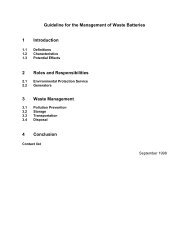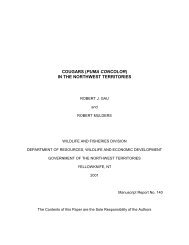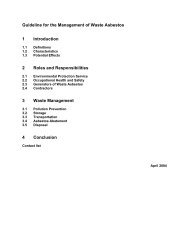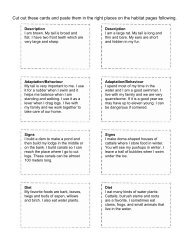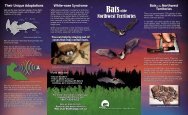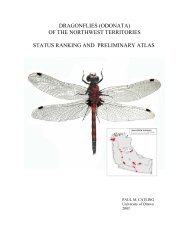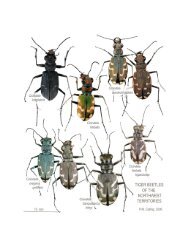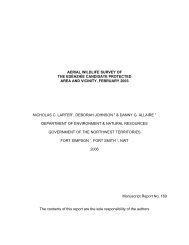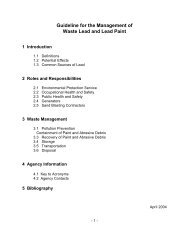Standard Operating Procedure (SOP) - Environment and Natural ...
Standard Operating Procedure (SOP) - Environment and Natural ...
Standard Operating Procedure (SOP) - Environment and Natural ...
- No tags were found...
Create successful ePaper yourself
Turn your PDF publications into a flip-book with our unique Google optimized e-Paper software.
<strong>St<strong>and</strong>ard</strong> <strong>Operating</strong> <strong>Procedure</strong> (<strong>SOP</strong>)<br />
Capture, H<strong>and</strong>ling & Release of Bears<br />
Wildlife Care Committee Primary Author: Dr. Marc Cattet Version 2 - 2011<br />
• When not in use, drugs at field sites should be stored in a<br />
labeled, locked, crush-proof, leak-proof container that is lined with<br />
absorbent material.<br />
• Darts should not be loaded with drug in a helicopter or motorized<br />
vehicle that is in motion.<br />
• All used drug must be recorded, including amounts lost in darts<br />
that missed the target.<br />
• Unused preloaded darts should be emptied at the end of each<br />
day.<br />
Most drug solutions are acidic <strong>and</strong> can cause corrosion of the dart<br />
components. Drug may also leak from darts with time.<br />
• If cleaning used darts that require disassembly, the tailpiece<br />
(flight) must be removed first in case the drug chamber contains<br />
some drug <strong>and</strong> is still under pressure.<br />
• Adequate steps must be taken to ensure that drugs used in bears<br />
do not enter the human food chain.<br />
Bears should be clearly marked to indicate they have received a<br />
drug <strong>and</strong> the individuals or agency performing the capture should<br />
provide contact information on the collar or ear tag (Cattet 2002).<br />
This information can be presented on collars in indelible ink or<br />
inscribed onto ear tags. Further, many of the drugs used to<br />
immobilize bears (other than Telazol) do not have established<br />
withdrawal times. Health Canada, therefore, recommends that bears<br />
immobilized with these drugs are not used for human consumption<br />
for at least one year after immobilization.<br />
4.1.2.2 Culvert (or Barrel) Trap<br />
Is: A technique where bait is used to attract a bear into a large culvert or<br />
barrel that is open at one end only, <strong>and</strong> often mounted on a trailer.<br />
- The bait is attached to a trigger mechanism <strong>and</strong>, when pulled,<br />
releases a door that closes <strong>and</strong> traps the bear inside.<br />
- This technique is often employed in areas accessible by road,<br />
such as around communities or industrial sites.<br />
- Other species may be trapped inadvertently (e.g., wolverine,<br />
wolf, etc) since this method of capture is non-specific.<br />
Recommendations:<br />
• Personnel using culvert must be trained in their safe use, <strong>and</strong><br />
individual traps must be inspected <strong>and</strong> serviced as needed<br />
before being used.<br />
• Guillotine-type doors should not be used because of their high<br />
potential to cause injury.<br />
Instead, doors should be designed <strong>and</strong> constructed with safety<br />
mechanisms to prevent injury to body parts that fall in the path of<br />
the released door.<br />
11



